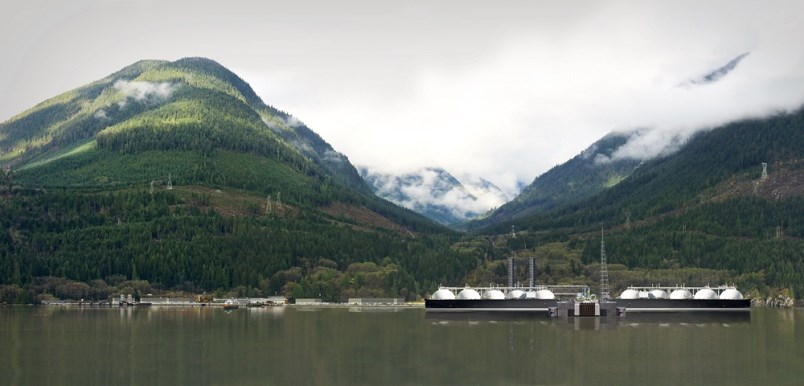—Update: May 22, 2025—
The Environmental Assessment Office (EAO) announced on May 16 that Woodfibre LNG was withdrawing its application to change its environmental assessment certificate to increase the facility’s storage volume of natural gas liquids, or condensate.
The November 2024 application requested to increase the volume of the storage capacity of condensate from 300 to 1,500 cubic metres.
Woodfibre LNG spokesperson Sean Beardow told The Squamish Chief that staff withdrew its application to the EAO in order to pursue a “more streamlined approach” that the legislation allows, by going through the BC Energy Regulator (BCER).
The BCER is another Crown agency of the provincial government that regulates such projects. While the EAO is involved before a project can start, the BCER regulates the full life cycle of energy resource activities in the province. Sometimes, approval from both regulators is required.
According to the EAO, an amendment to the certified project description in the environmental assessment certificate would also be required to increase condensate storage capacity.
“We’ll continue to work with the BC Energy Regulator (BCER) to seek amendment of the facility permit to increase storage tank size," Beardow said.
"Pending completion of that, we’ll ask the BCER to recommend amendment of the Environmental Assessment Certificate to the EAO. This approach will maintain rigorous review of our requested change while minimizing some duplication of process and strain on regulator resources," he added.
“Woodfibre LNG is committed to working with regulators to find ways to streamline regulatory process without losing any of the rigour that has made B.C.’s regulatory system among the best in the world.”
BCER
In the wake of the trade war with the current U.S. administration, the provincial government tabled legislation in late April that aims to speed up permitting for renewable-energy projects.
The legislation would mean BCER would be the primary permitting agency for renewable-energy projects and transmission lines.
However, the premier has said the new process will not be used for oil and gas pipelines or to power LNG projects
—Original story: Jan. 2, 2025—
Woodfibre LNG has applied for an amendment to its Environmental Assessment Certificate, which was granted by the provincial government in 2015.
It is common for projects to apply to the Environment Assessment Office (EAO) for amendments to the certificate, as any changes to the project as it was originally assessed must be approved by the EAO.
The Woodfibre LNG application for an amendment, which was dated Nov. 26, 2024, is for the “construction and operation of increased condensate storage” from 300 cubic metres (m3) to 1,500 m3.
So, the company wants to have a bigger tank on the property than originally planned, in other words.
The company says this request is in order to "align with current industry practices and reduce the frequency that condensate needs to be removed from the project site."
But, hold up—what is condensate?
"Condensate is a mixture of hydrocarbons extracted from natural gas as part of the production of LNG," said Woodfibre LNG spokesperson Sean Beardow in a Dec. 31 email to The Squamish Chief.
"Condensate is stabilized to allow for safe shipping and can be used in the production of multiple products such as gasoline, jet fuel, diesel, and heating fuels."
The condensate produced at the Woodfibre LNG export facility will be shipped off-site, Beardow said.
"The shipping location for the condensate will depend on the buyer, but it is anticipated that the condensate will be safely shipped to the Lower Mainland," he added.
In addition to the increased size of the tank, the amendment application proposes corresponding changes to its foundation and secondary structure to hold a larger quantity of condensate.
"By increasing on-site storage capacity, Woodfibre LNG can decrease the frequency of condensate barge activity to once per month. This decreases impacts of marine transportation and the frequency of transferring condensate to barges," Beardow said.
The amendment application seeks a higher storage volume, but the makeup of the condensate and the rate at which the facility will produce condensate remains unchanged, according to Woodfibre LNG.
"The environmental and safety aspects of the condensate storage are carefully considered in WLNG’s design approach. In the highly unlikely event of condensate release from the tank, a secondary containment system is in place that features an impermeable barrier and can capture 110 % of the total volume of the tank," said Beardow.
The EAO published on its site on Dec. 19 that it has received the amendment application and is currently reviewing the request.
A public comment period will be announced soon, according to the EAO.
Woodfibre LNG is an under-construction liquefied natural gas export facility to be fed by the associated FortisBC Woodfibre-Eagle Mountain pipeline.
Woodfibre LNG is expected to produce up to 2.1 million tonnes per year of LNG that will be exported overseas.
"It will also include [a] land-based natural gas processing and liquefication facility, condensate storage, floating storage tanks to store up to 250,000 cubic metres, and offloading unit with an associated jetty … floating accommodations for workers, and … supporting buildings," reads the EAO site.



